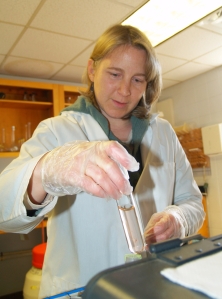As burgeoning growth on the Georgia Coast puts additional pressure on the fragile coastal environment, scientists at the Skidaway Institute of Oceanography are researching new techniques to monitor coastal water quality.
Scientists can measure water quality several ways. One method is to measure the water’s chemical characteristics, such as oxygen and nutrient concentrations. Skidaway Institute researcher Elizabeth Mann is investigating another technique – using a group of microscopic organisms as a bioindicator of water quality.
“When you measure the chemical composition of the water, you essentially get a snap shot of all the individual components in the water at the time you take your sample,” Mann said. “We are trying to determine if the micro-organisms in the water will give us a better picture of water quality because living cells must adapt to all of the stresses in an environment over a longer time span.”
Mann’s research focuses on one of the smallest of microscopic algae or phytoplankton called cyanobacteria. These organisms are less than 2 microns in size and form the base of the food web. Like plants, cyanobacteria such as Synechococcus contain chlorophyll and manufacture their own food through photosynthesis.
Cyanobacteria have many characteristics that make them potentially good indicators of water quality. Synechococcus are abundant in Georgia’s coastal waters and are relatively easily isolated and grown in the laboratory. They can also be identified and counted using flow cytometry, a technique that can accurately count up to 500 cells a second.
“Cyanobacteria can serve like a canary in a coal mine,” said Mann. “Changes in Synechococcus populations may help monitor the condition of the environment in which they live because these small phytoplankton are more sensitive to toxic metals such as copper and cadmium than larger marine algae.”
Mann is examining the water quality in the Savannah River by comparing conditions in that heavily industrialized estuary to the more pristine Altamaha River.
“The abundance of cyanobacteria, including Synechococcus, is much lower in the Savannah River than in the relatively pristine Altamaha,” Mann said. “Not only is the total number of cyanobacteria lower in the Savannah River, but certain types of microbes abundant in the Altamaha River are essentially absent from the more heavily impacted Savannah River.
In addition, Mann said, adding water from the Savannah River to populations of estuarine phytoplankton from more pristine locations leads to a decrease in the abundance of cyanobacteria and other small phytoplankton.
Mann’s work is just beginning. A next step will be to identify the types of contaminants responsible for low Synechococcus numbers in the Savannah River and to determine what effect stunted cyanobacteria populations have on the larger organisms in the food web that prey on these small plants.


